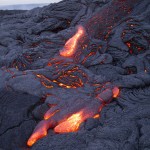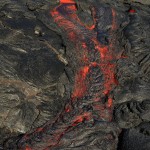The lava has been entering the sea for over a month now. I have wanted to hike out, but life and other commitments have consistently intervened. With off-island guests, I made the offer to lead a hike out to the flowing lava. My sister-in-law Darcy was the only one that took me up on the offer, the prospect of a 2am wake-up and a two hour trek across rough ground too much for some. We left the others in bed.

The extraordinarily bright LED lights Darcy and I carried were extremely helpful in crossing the older flows. The dark basalt just soaks up any light you throw about. I carried a dive light that put out up to 1000 lumens. With this light I could look 100 yards or more ahead to choose a course through the lava fields. A light this bright did chew through the battery quickly, even the high capacity 18650 lithium cells I was using. Both lights required fresh cells to complete the two hour hike.
We knew exactly where we were going. Friends had been out to the lava just a few days before and Josh had posted waypoints to the current ocean entry. Using Josh’s waypoints we navigated to the ocean entry with no trouble, just to find that the ocean entry had ceased to be. Some time in the previous day the flow had become interrupted. There was no glow along the sea cliffs, no plume of steam to be seen. Later, after dawn we checked again, nothing. We could see where the lava had been flowing over the cliffs, right where it had been reported.
Shortly after we arrived at the breakout we spotted the lights of a lava tour boat just offshore. With no active ocean entry to view, the passengers aboard had to have been disappointed. They must have been able to see the breakouts we were exploring, and would have seen our lights as well. But we were hundreds of yards from the shoreline, too far for a good view. I can only imagine how envious the passengers of that boat were as they circled offshore in the heavy swell.

With the arrival sunlight the first helicopters also arrived. It was rather hard to miss the thud-thud-thud of helicopter rotors appearing just overhead. The Blue Hawaiian chopper made a pass at the sea cliff, no doubt discovering what we had found, no active ocean entry. A moment later they headed right for us, circling just overhead of our position and the breakouts. Again Darcy and I realized that we were most likely the subject of a fair amount of envy, as the helicopter passengers watched us just a few feet from active lava. We just waved.
We spent a couple hours in front of the lava flow, photographing and taking video. This was the first flow I had had the Canon 60D available. Thus I took a fair amount of high resolution 1080p video for my archive. I suspect the footage will make its way into a video project sometime soon.
Eventually we knew it was time to head back across the lava fields. As we headed out from the breakout the airshow overhead continued, with three helicopters and a fixed wing plane circling the breakouts we had just departed.
Darcy was absolutely thrilled she had taken the hike to get to the lava. We were both tired and sore from the effort, and in sore need of showers. With camera cards full of photos this trip will be well remembered.
A Few hints…
This is my fifth trip out to the flowing lava, requiring my longest hike over the flows to date at just under three miles each way. These trips have taught me a lesson or two. Going onto the lava is an inherently risky proposition and one must accept that risk. With a little knowledge and preparation the risks can be mitigated.
Proper footwear is a must! Sturdy boots or shoes required to traverse the fresh lava surface. The freshest lava is covered by a layer of volcanic glass shards that crunch underfoot at every step. Occasionally bits of rock that looked solid enough will give way and collapse underfoot. I have seen folks start out onto the lava in sandals or rubbah slippahs, they quickly turn back for good reason. You may not want to use the new boots either. Your footwear will look a bit chewed-on after this hike as the rough lava takes its toll.
A GPS or GPS app for your phone is very useful. Lately I have been playing with an app called EveryTrail that has some nice features. Getting lost is difficult with the ocean on one side and the pali on the other. But a GPS can indicate how far you have come as well as the route and distance back to the vehicle. You can also use GPS to stay on the old highway right-of-way to avoid trespassing on private land.
This is Puna, the “interesting” side of the island. Leave nothing of value in the car, even when parking at the county viewing area.


Thank You Andrew! I so enjoyed our trek to the Lava Flow! Following you in the pitch dark under a few bright stars to guide us and your powerful lights to light our way – it was spectacular. The weather was perfect, the timing was spot on and the experience was not to be missed! Thank You!